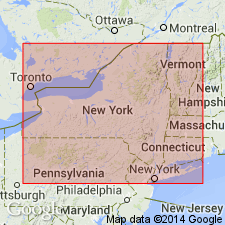
- Usage in publication:
-
- sandstone of Oneonta
- Modifications:
-
- Named
- Dominant lithology:
-
- Sandstone
- AAPG geologic province:
-
- Appalachian basin
Summary:
Name Oneonta introduced in this report. Sandstone of Oneonta used interchangeably with Montrose sandstone. Younger than Chemung group.
Source: GNU records (USGS DDS-6; Reston GNULEX).

- Usage in publication:
-
- Oneonta Formation
- Modifications:
-
- Overview
- AAPG geologic province:
-
- Appalachian basin
Summary:
The Oneonta Formation occurs at the top of core PT-1 and the lower parts are exposed along Rte 30 near Grand Gorge. Unit is composed of red, green, and gray mudstones with subordinate red to gray, very fine- to fine-gained sandstones. Mudstones range from fissile and relatively nonbioturbated to blocky and intensely bioturbated with desiccation cracks throughout representing flood-basin deposits. Sandstone sets are sharp-based, cm- to dm-thick sheets and lenses, cross-bedded or planar bedded flood deposits. The major sandstone bodies are interpreted as fluvial channel deposits. Gradationally overlies Gilboa Formation in the Schoharie Valley. Overlies Manorkill Formation to the east. Age is Middle and Late Devonian.
Source: GNU records (USGS DDS-6; Reston GNULEX).
For more information, please contact Nancy Stamm, Geologic Names Committee Secretary.
Asterisk (*) indicates published by U.S. Geological Survey authors.
"No current usage" (†) implies that a name has been abandoned or has fallen into disuse. Former usage and, if known, replacement name given in parentheses ( ).
Slash (/) indicates name conflicts with nomenclatural guidelines (CSN, 1933; ACSN, 1961, 1970; NACSN, 1983, 2005, 2021). May be explained within brackets ([ ]).

